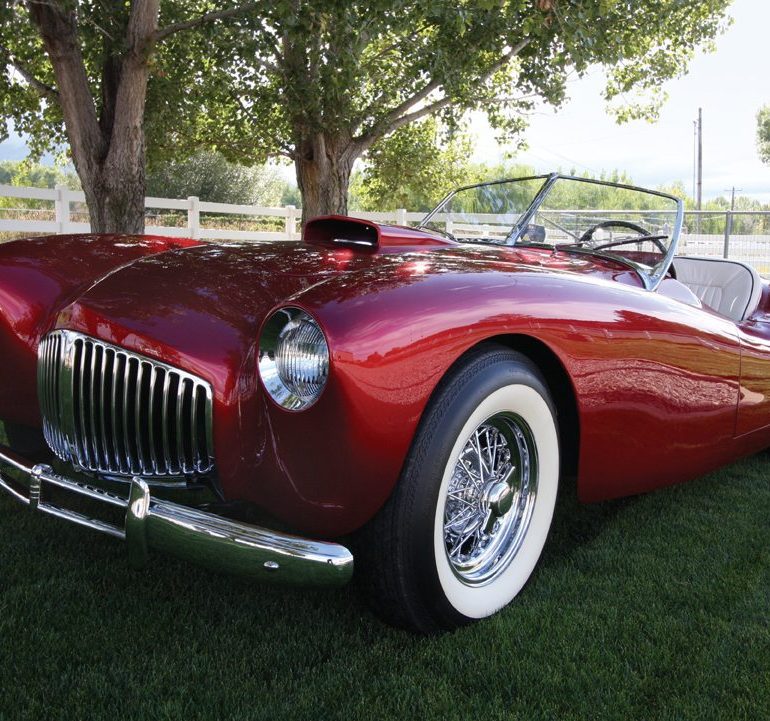1953 Glaspar G-2
Costa Mesa, California, was home to Glasspar, a company that built fiberglass boats in the late 1940s. With the launch of the Glasspar G-2, the company became the first and, for several years, the largest manufacturer of fiberglass automobiles—before the Kaiser Darrin or the Chevrolet Corvette were produced in Detroit. Bill Tritt, founder of Glasspar, influenced Chevrolet, Volvo, Disneyland, Kurtis and several small automobile manufacturers because of the G-2.
Bill Tritt and Glasspar
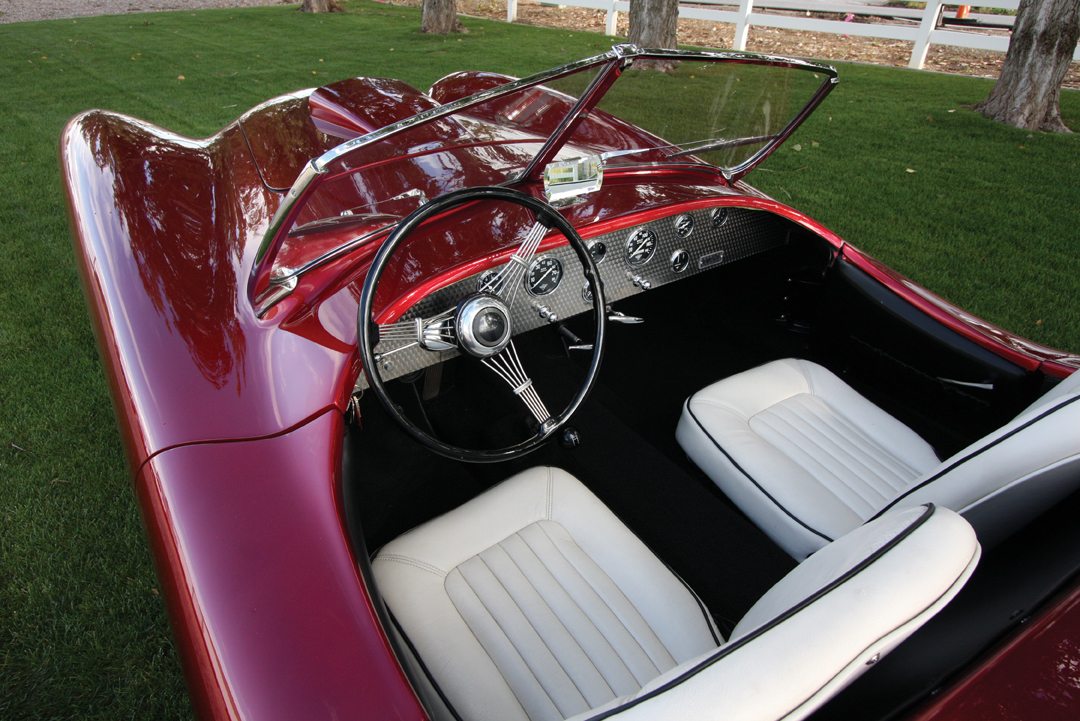
Born in 1917, Tritt had a lifelong interest in boats. In the years before World War II, he studied marine architecture and boatbuilding then worked for Douglas Aircraft during the war. As a sideline, he built several catamaran sailboats. In 1947, his sideline became serious. Approached by a friend, John Green, to build a light, corrosion- resistant racing sailboat, Tritt suggested fiberglass reinforced plastic (FRP) as a good construction material. Green agreed, and they enlisted Otto Bayer, who had experience with fiberglass from working at Wizard Boats, as the laminator. The boat, named Green Dolphin, was a success, and Tritt and Green created Green Dolphin Boat Works. The company grew, additional partners came on board and the company became Glasspar Body Works when it moved to its new, larger facility in Costa Mesa. Glaspar went on to become one of the biggest fiberglass boat builders in the United States, with four plants and 15-20 percent of the market in the mid-1950s. Most of their products were smaller boats, up to 21 feet, although shortly before the company was sold to Larson Boat Works in 1969, they began producing 21-25-foot oceangoing boats.
Automobiles
Tritt’s interests went beyond boats; he also liked sports cars. When Air Force Major Ken Brooks showed Tritt his hot rod project, Tritt expressed an interest in designing and building the body for the car. Brooks had stripped a Willys Jeep and built a hot V8 engine for the car, but he had no body. He wanted something unique and sporty. Tritt once again suggested fiberglass. A friend, Brandt Goldsworth, had used the material to build a one-off body for Kaiser, so Tritt knew it would work for an auto body.
Tritt remembered it this way, “Ken Brooks was building a hot rod—something to go fast in and have fun. The first time I went for a ride in it—it was too exciting for me. It was a fast car, and had no floor—or body yet. I just saw the ground rushing by…. Ken was a wonderful mechanic, but didn’t have an eye for design, and the chassis and drivetrain was from the hot rod he was building. Ken was going to have the body built out of aluminum, which was going to be expensive. I was already building fiberglass boats, and convinced him that fiberglass would be durable—and much more cost effective—for a car body.”
With Brooks’ agreement, Tritt developed a design loosely patterned after a Jaguar XK-120. In Tritt’s opinion, the Jag was too tall, so his design featured low sides with small doors. He actually thought of the doors as a safety feature—in the case of an accident, the small size of the doors would keep the occupants in their seats. His grille design was another departure from the Jaguar. For Brooks’ car, it would be low, narrow and have vertical slits. The car, named the Brooks Boxer because Brooks’ wife loved Boxer dogs, was shown at the 1951 Los Angeles Motorama, where it received positive reviews and was the subject of a number of magazine articles. Glasspar was about to be in the automobile manufacturing business. But there was a problem to overcome. The Korean War had begun in 1950, and Tritt had problems obtaining the polyester resin he needed to go into production of his car. That was solved by the interest the Naugatuck Chemical Company expressed with the Brooks’ Boxer. They ordered a car to promote their business and subsequently made sure Tritt had all the resin he needed. The Naugatuck car was called the Alembic I, and was shown at the Philadelphia Plastics Exhibit in 1952. The result was even more publicity, including articles in Life, The New York Times, The Wall Street Journal and many automobile magazines.
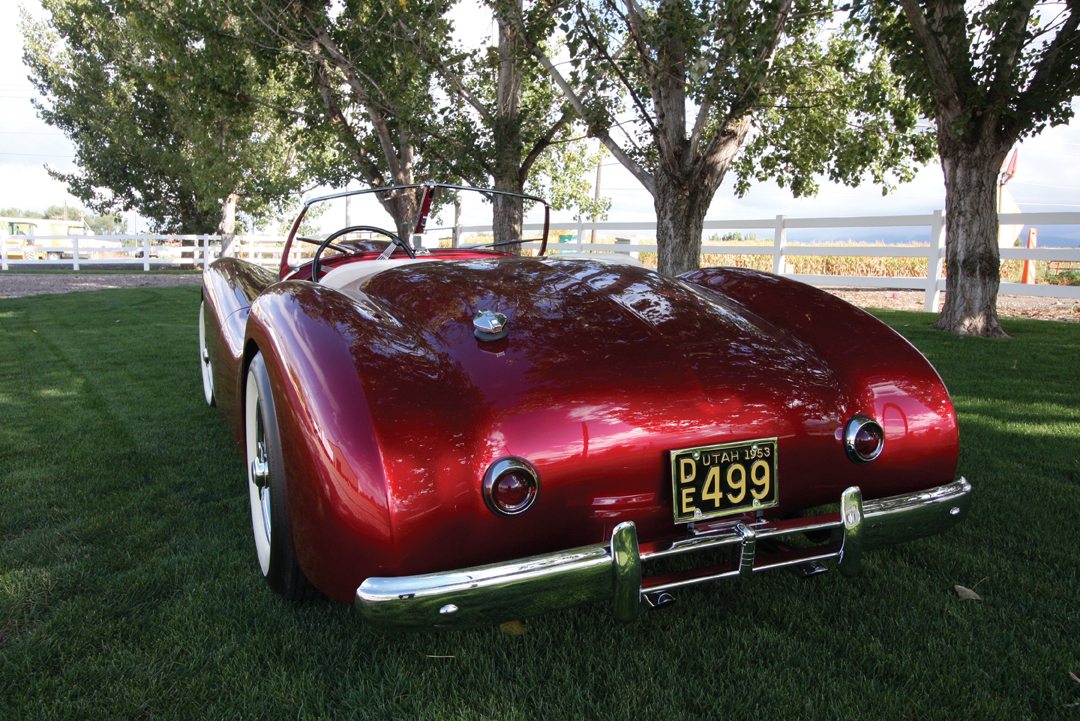
In March 1952, GM styling head Harley Earle was shown the Alembic I and arranged to borrow it for evaluation. That evaluation led to the Corvette, although GM decided to use a pressure molding process for the bodies rather than the stronger, more durable and more expensive hand-laminating that Glaspar used for the G-2.
Now that Tritt had both resin and publicity, he launched the G-2 in 1952. It could be bought as a complete car or in kit form. Kits sold for $650, with a chassis for the kit available at an additional $200. Eventually, there were three different chassis used on the G-2. Tritt had the chassis for the kits designed by Harold “Shorty” Post and built by the Post Body Shop. Because there was interest in racing the G-2, Tritt had a chassis for the racing versions of the G-2 built by the Mameco Company. For factory-built cars, Tritt modified the Post chassis so it was stronger and more similar to the Mameco design. Post used a 2-inch x 2-inch square tubular frame, and Tritt reinforced it with gussets for additional rigidity. Eventually, Tritt stiffened the chassis even more by using 2-inch x 3-inch tubing. The kit came with a 3/16-inch thick body weighing 185 pounds, with molded cockpit and trunk and aluminum posts for the two-part windshield. Options included a molded dashboard, second door, hardtop, bucket seats, hood scoop and wind wings.
Around 100 G-2s were produced, including the Boxer and Alembic, but only about ten were complete cars produced by the factory through 1955. These sold for $2,950 and some were sold to celebrities like Gary Cooper. Both the production cars and the kits would accept almost any engine. Nearly all the V8s of the era were used in G-2s, with the Ford flathead V8 the most popular. Only one had a Cadillac engine.
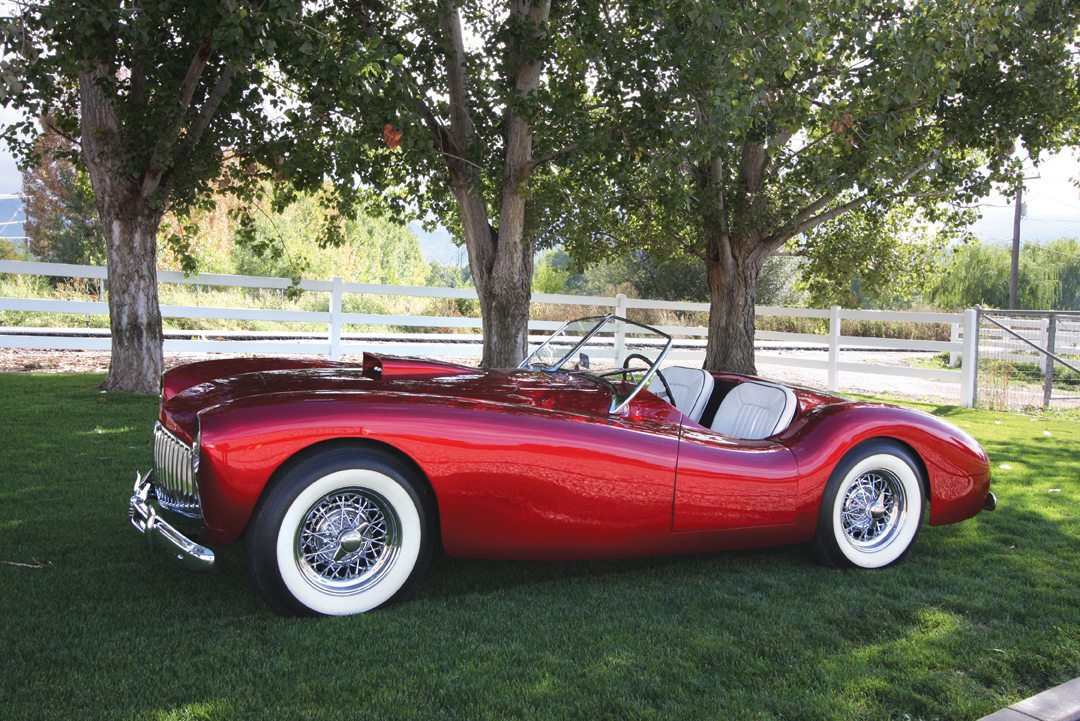
The popularity of the G-2 apparently infected at least one other potential automobile magnate—Robert “Woody” Woodill. Woodill was a California Dodge and Willys dealer who wanted to build a sports car using Willys pieces and a modified G-2 body. Tritt created a body with raised cockpit cowls, squarer rear fenders to use Willys Aero taillights and a non-functional hood scoop. Two Woodill Wildfire Series I cars, using a Willys engine, were produced, and one was shown at the 1952 Los Angeles Motorama. Unfortunately for Woodill, Kaiser bought Willys and went to Dutch Darrin to remold a G-2 body into the Kaiser Darrin. Now with its own sports car, Kaiser would not support Woodill’s project using Willys components. Woodill would not be denied his sports car, so he redesigned the Series I body and built his Series II Wildfire on the upgraded Glasspar chassis. Glasspar provided Woodill with the modified G-2 bodies, and Woodill eventually produced as many cars as Glasspar, around 100, by 1958. As with Glasspar, only about ten were factory- assembled cars; the rest were sold as kits. The production version sold for $3,260; the kit body cost $995 plus $228 for the chassis.
Tritt and Glasspar impacted other automobile manufacturers and specialty car builders. The Alembic I was scrutinized by Harley Earle and GM designers during planning for the Corvette. Dutch Darrin used a G-2 as the basis for the Kaiser Darrin. The Singer Car Company had Tritt adapt a G-2 body to a Singer SM 1500 chassis, and the car, called the Vaughan Singer 1500, was shown at the New York Auto Show, although no additional bodies were ever provided to Singer. One Yankee Clipper was produced by the Strassberger Motor Company using a G-2 body. They had hoped to enter the fiberglass automobile market, but only that one car was ever built. Disney came to Tritt to design a single-seater car for their Autopia track in Anaheim, and Glasspar built 30 bodies for that attraction. In 1953, Assar Gabrielsson, founder of Volvo, visited the U.S. He was interested in Volvo producing a sports car, and was impressed with the Glasspar G-2. He contracted Glasspar to build a prototype sports car on a special Volvo tubular chassis. Called the Volvo Sport or P1900, a total of 67 cars were built in 1956-’57 until the program was cancelled by the new Volvo chief executive. Apparently, every car built lost money.
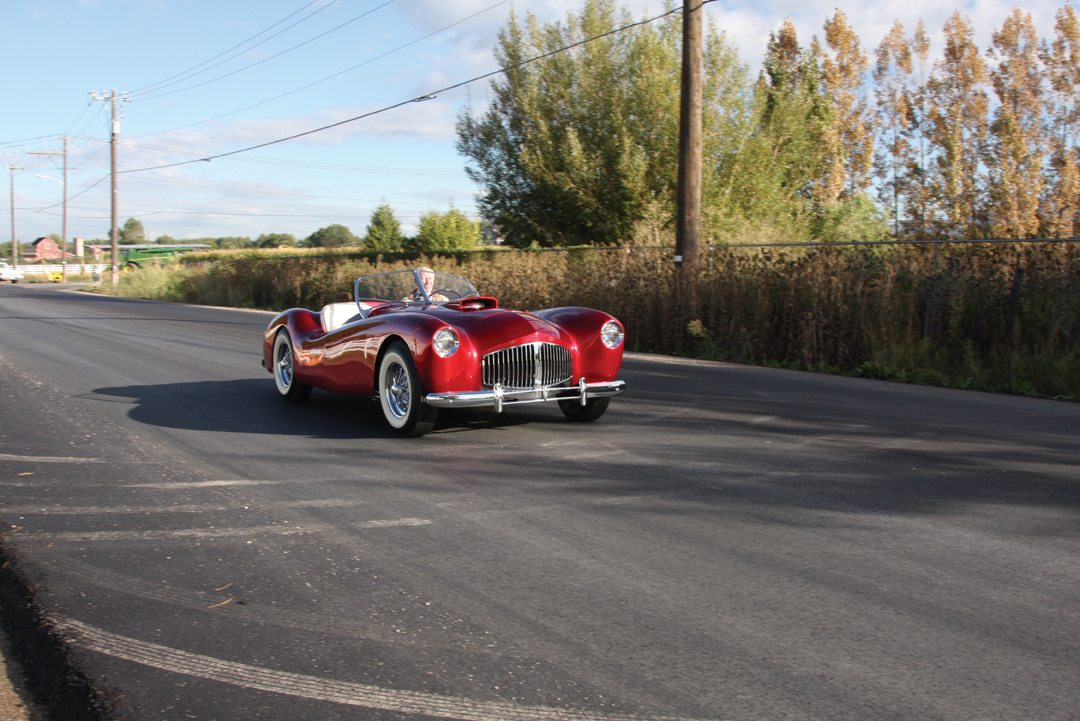
Tritt had one more automobile adventure he wanted to launch— a complete, modern sports car. In 1955, Tritt designed and built the Ascot. It had a more modern design than the G-2—looking somewhat like a Lotus 7 for grown-ups—a great power-to-weight ratio, 50-50 weight distribution, roll-up windows, convertible top and large trunk. The Ascot used a hot-rodded Studebaker engine and many Studebaker components. It weighed 1,750 pounds and was to sell for $2,600. Tritt built five, but the Glasspar Board of Directors decided the company needed to concentrate on its boat business, ending the Glasspar automobile adventure.
G253038
Like most car guys, DeWayne Ashmead subscribes to Hemmings Motor News. In 1999, he saw a Woodill Wildfire for sale. “I liked it when I saw it.” But the price was too high. The car was advertised again in 2000 and was priced more realistically, so he bought it. Then came the discoveries, the most significant of which was that it was not a Wildfire but a Glasspar G-2. It needed a lot of work, so a restoration was begun. That’s when they discovered a VIN stamped into the frame—G253038. That number and the chassis construction led Ashmead to believe that the car was a Glasspar, not a Woodill, a fact that was confirmed in a discussion with Bill Tritt. Tritt told Ashmead that the car, the 38th built, had been the only factory-built car with a Cadillac engine and transmission. The differential and suspension were Ford-sourced. The restoration took on a new intensity because of the importance of the Glasspar G-2 and the uniqueness of this particular car. The importance of the car was validated by the Smithsonian Intuition when it chose to house a Glasspar G-2 because it “paved the way for today’s kit car industry and pioneered the use of fiberglass in automobile construction.”
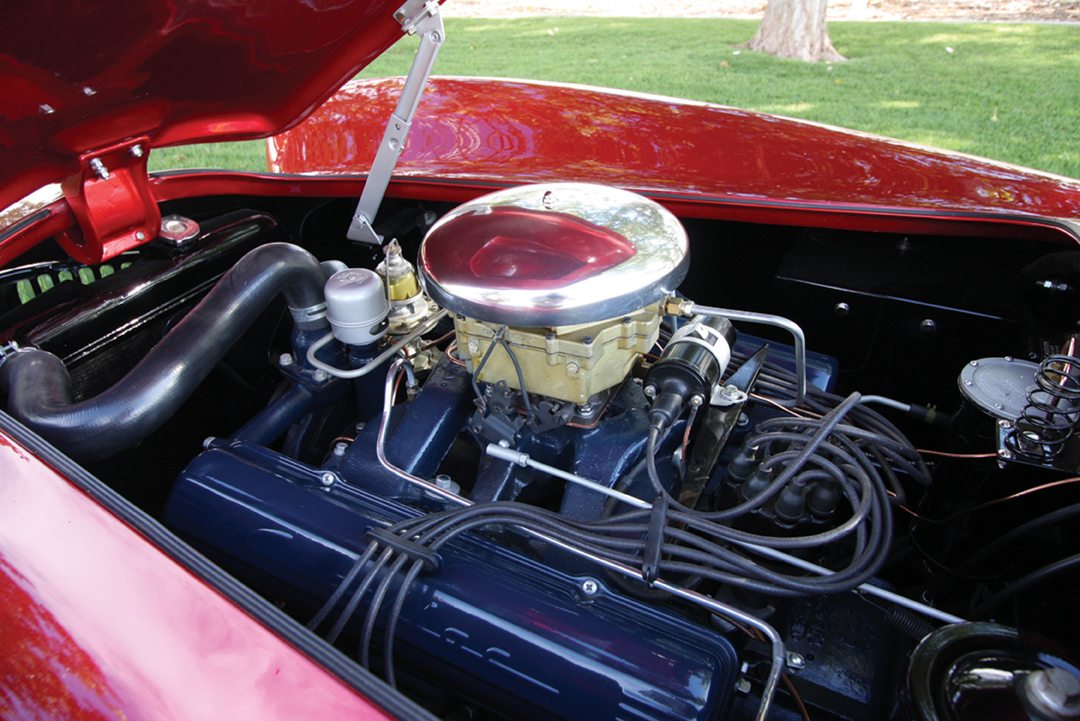
Ashmead started digging into the car’s history and learned a lot. Originally sold in the San Francisco Bay area, it somehow made its way to Hawaii. In Hawaii, it was owned by a member of the military who ultimately abandoned the car at Don’s Aloha Chevron Garage in Honolulu. It was found and purchased by Floridian Joe True, but there were problems. The Cadillac engine and transmission had been pulled and used in a hot rod, and the VIN plate had been removed. Without that VIN plate, Hawaiian authorities would not issue a title, and considered it a kit car. Without a title, it could not be shipped to the mainland, but if the car had an engine, Hawaiian authorities said the serial number of the car it came from could be used. True had a 1969 Fairlane engine, transmission and Mustang floor shifter installed, and the Fairlane data plate was attached to the body. He was then able to ship the car to California and drive it to Florida.
After True sold the car to Bob Day in Pennsylvania, Day tried to title it as a Glasspar, but there was another problem. Pennsylvania authorities had never heard of a Glasspar. Somehow, though, they had heard of Woodill, so that is how the Pennsylvania title read—still using the Ford VIN. It was still considered a Woodill Wildfire when Ashmead bought it.
With Tritt’s advice, Ashmead restored the car to its original, factory-correct glory, and a glorious car it is. A 1952 Cadillac V8 and three-speed transmission were found, correct Lincoln bumpers were installed, the missing hood scoop was re-created, Cadillac wire wheels were installed, the headlights were Frenched, a Jaguar XK-120 windshield was acquired (only the factory cars used these windshields) and it was painted Cadillac candy apple red. Ashmead took what had become a sow’s ear and returned it to silk purse condition. It is obviously not a car of the 21st century, but it has likely influenced some modern lines. It is low and sleek and powerful and just damned sexy. Just imagine a car that weighs something around 1,500 pounds powered by a 5.5-liter V8 with a Rochester four-barrel carburetor and producing 133 bhp at 3800 rpm. You don’t need the 400 horspower of the 6-liter V8 in the later Caddy CTS V to make this car fly. It is a rocketship. It has a center of gravity somewhere near the seat bottoms, an engine that is placed behind the front wheels for a front-mid-engine arrangement, and a 50-50 weight distribution. So it also handles, even on its narrow wire wheels and tall tires.
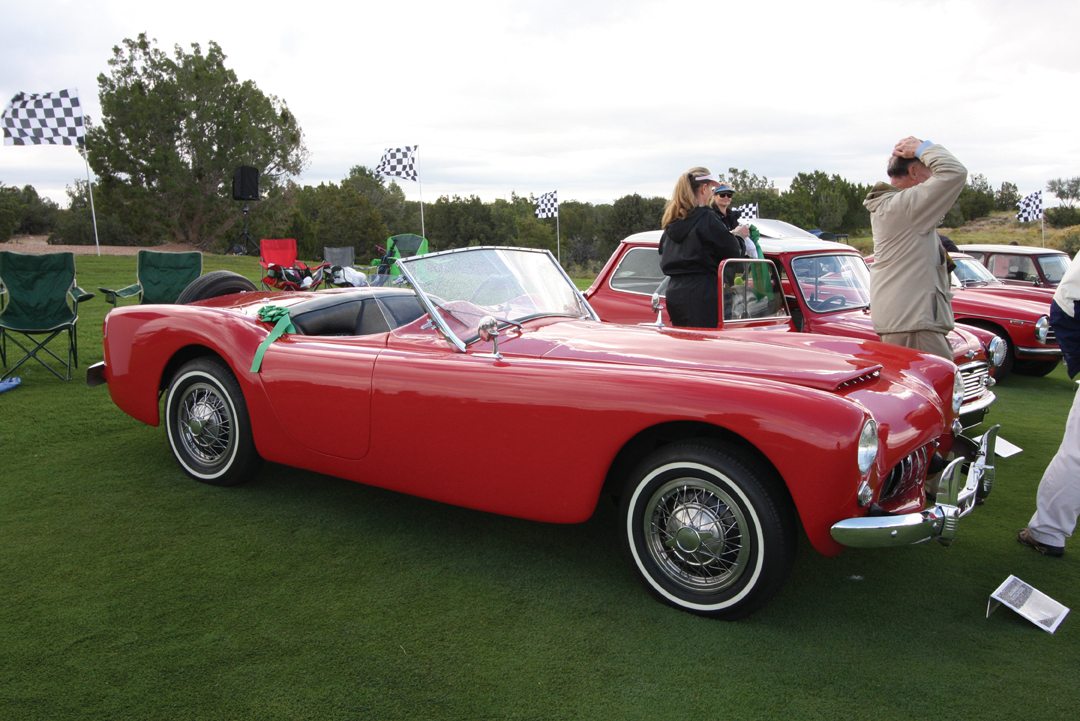
bureaucracies in Hawaii and Pennsylvania, so for a while the
car was thought to be a Woodill Wildfire, a car based on the Glasspar.
Riding Impressions
Tritt made the doors of the Glasspar G-2 small so no one would fall out if the doors opened. Still, the car was not impossible for an adult to enter and exit gracefully. Once in, though, you had to have short legs. I was pleasantly surprised when I was able to slip behind the wheel of the G-2 without a lot of contortions. I settled into the seat—good support—found the appropriate switches, acquainted myself with the shift pattern and was about to start the car when I tried to put my left foot on the clutch. You just have to have short legs to drive the G-2. I could not get my foot onto the clutch—when I pulled my foot back, which is only possible by bending your knee and raising your leg, I hit the lower edge of the dashboard— autographed by Bill Tritt, by the way. I tried several times, even shifting my butt to the left to try to get more room to lift my leg and reach the clutch—nope, wasn’t going to happen. Luckily, Scott, Ashmead’s restorer, was available and had shorter legs than me. He drove, and I rode.
We drove away from the shop onto some smooth, new roads. As I suspected, the acceleration was neck snapping! Light weight + moderate power = zoom! We only had 90-degree corners on our drive, but the G-2 cornered flat, a little surprising since the suspension is not very sophisticated. A bit of acceleration leaving the corner brought the rear end out, but Scott easily got it under control—nothing like a car that steers with the accelerator. The ride, even on the new roads, was a bit harsh, but I am the kind of guy who likes a stiff suspension. It’s certainly not a car you want to take on a long trip, but I can only imagine how much fun it is to drive on twisty roads. I watched as Scott shifted, and the Cadillac transmission seemed nice and smooth—no drama at all. First gear is under your right leg, but with the kind of torque this car has, who needs first!
All in all, this is an incredibly fun car—lots of smiles, lots of head turn, great acceleration and good handling. The only thing that might have been better is if I had been able to fit it in.


